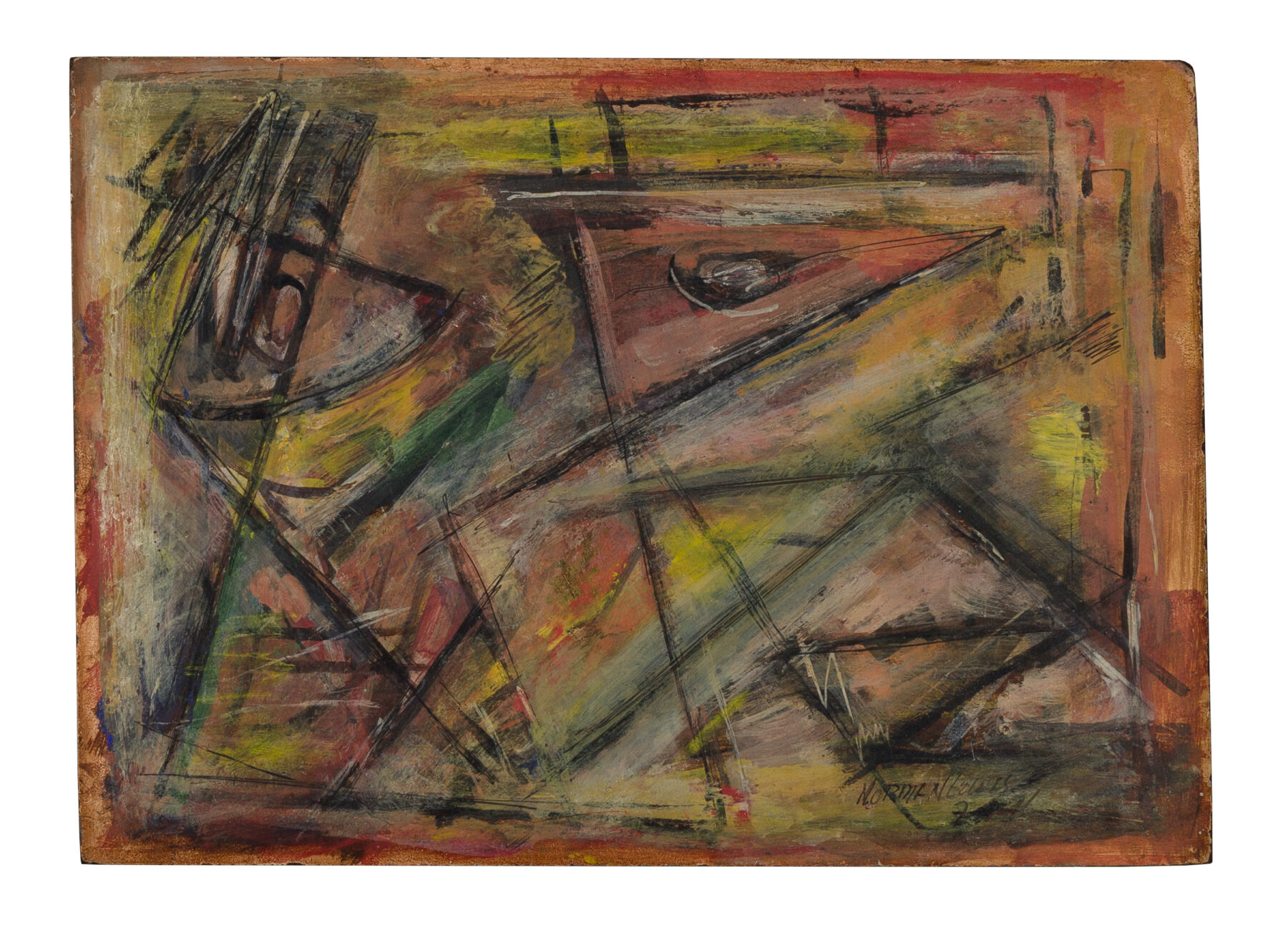Norman Lewis
Norman Wilfred Lewis was born in Harlem to working class immigrants from Bermuda. As a child, his family instilled in him a solid work ethic and the importance of education, attributes that he would carry throughout his career as an artist and teacher. The Lewis’ were among a small number of black families in Harlem during Norman’s childhood, and the racial inequality he observed during his youth impacted his art throughout his career.
The Harlem Renaissance was in full swing when Lewis came of age as an artist, and he was deeply engaged with the local artist community. As a burgeoning painter, Lewis shared studio space with Augusta Savage, the influential educator and sculptor. Although he was primarily self-taught, Savage was an important mentor and teacher to Lewis. In the 1930s Lewis attended meetings at Studio 306, a center founded by Charles Alston and Henry Bannarn, where black artists, writers, actors and musicians met to discuss current events. Lewis was also a founding member of The Harlem Artists Guild, an organization that grew out of 306. From 1933-35, he studied at Columbia University Teacher’s College and at The John Reed Club art school.
In 1934, Lewis was accepted into the Federal Art Program of the Works Progress Administration (WPA). He led classes at the Savage studio, the Harlem Music-Art Center, and the George Washington Carver School where he taught alongside artists Elizabeth Catlett and Charles White. It was through his association with the WPA that Lewis met many of the influential and diverse members of the New York School, a loose association of young artists who shared a collective new direction in their art. Influenced by his peers, Lewis abandoned his early figural style of social realism in favor of abstraction.
Lewis became a key figure in the first generation of Abstract Expressionist artists in New York. He developed a unique style of dense, geometric abstractions, with fluid forms suggestive of figures in movement . Lewis’ paintings were inspired by his interest in jazz music, nature, ancient ceremonial rituals, and themes related to the Civil Rights movement. His career evolved alongside prominent Abstract Expressionists including Jackson Pollock, Ad Reinhardt, Willem de Kooning, Clyfford Still, and Lee Krasner. In 1950, he was the only black artist to participate in the famous closed-door sessions defining Abstract Expressionism held at Studio 35, organized by de Kooning and Franz Kline.
Lewis received national recognition for his abstract works completed in the 1940s and 1950s in numerous exhibitions throughout the country. In 1946, Lewis was represented by the prestigious Marian Willard Gallery, who supported many other abstract artists. He had his first solo exhibition at the gallery in 1949, followed by six more throughout the next decade. In 1951, the Museum of Modern Art included his work in the exhibition Abstract Painting and Sculpture in America, a defining moment for the Abstract Expressionist movement. Lewis was the first African American artist to receive the Carnegie International Award in Painting in 1955. Thefollowing year, Lewis was selected to represent the United States in American Artists Paint the City, an exhibitionat the Venice Biennale. Lewis and Jacob Lawrence were the only African American artists included.
The present work, Untitled, was painted in 1946 when Lewis achieved his breakthrough in the New York art world. Painted in an all-over compositional style, the work features bold, graphic black lines centered on the board. The sharp, angular lines intersect and create interesting shapes throughout the painting, which Lewis highlighted with bright yellow, red, green, and white paint. The irregular shapes and vibrancy of color and line evoke the improvisational structures of jazz, which inspired Lewis and his contemporaries. Lewis used a similar graphic and expressive style in the two compositions Woman and Phantasy II.
Untitled was painted simultaneously to the mature periods of Lewis’ more renowned contemporaries. In 1947, Pollock began his monumental drip paintings for which he is primarily known. While Pollock’s reputation lies in his large-scale works, he also worked on a smaller scale, as in Phosphorescence, which bears similarity to Lewis’ concentrated and controlled compositions that emphasize line and gesture.
Despite decades of artistic achievement and favorable exhibition reviews, it is only in recent years that Lewis has begun to receive the attention and recognition achieved by his Abstract Expressionist peers. Since his death, Lewis has been featured in numerous group and solo exhibitions, including his first comprehensive museum overview at the Pennsylvania Academy of Fine Arts in 2015 curated by Ruth Fine.
Norman Lewis
Untitled, 1946
Oil on masonite
10″ x 14″
Signed and dated lower right
Provenance
Bill Hodges Gallery, New York
Patricia Scipio-Brim, New York, acquired from the above, September 1,2012
Estate of Patricia Scipo-Brim, Swann Auction Galleries, Sold February 6, 2025, lot 4
Private Collection, Michigan, acquired from the above

